|
I have used a balance beam scale for years in my reloading. A few months ago, I was surprised by my grandsons during a visit and didn't realize till later that they had been in my reloading tools. Bits and pieces of my scale were… unserviceable. That old scale gave me good service, but I wanted something with just a little more versatility, something easy to use and set up. Something digital.
Note to all the grandma's out there: I keep the tools separate from the powder, separate from the primers, separate from the loaded ammo. I don't know how the grandsons got hold of my scale, but you can be sure they didn't get into anything that might have hurt them.
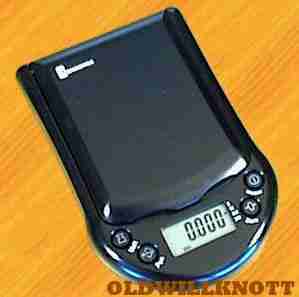
Jennings JS50X digital scale
|
Anyone can buy a good, serviceable, balance beam scale for about $50.00. Lyman, Lee, Hornady and RCBS all market scales for under $50.00. Digital scales for reloading cost about $100.00. So I went online and did some searching. There are many different digital scales out there, and some of them have unbelievable range, versatility and accuracy. Some of them sell for over a thousand dollars. Then I found Old Will Knott (www.oldwillknott.com). He bills himself as a "merchant of fine weighing scales." His catalog has just about any type of scale you would want. I was intrigued with the Jennings JS50X digital scale. I ordered one. With shipping and handling, the toll was $65.80 on my Visa card.
When the scale came in, I decided to give it a test run, so I installed a battery and read the instructions, and then calibrated it. I noticed a few things in the instructions. This scale will weigh in grams, grains, or carats, and has a tare function. I'll explain later how to use the tare feature. I set the scale to weigh grains and took out some Remington factory bullets and weighed them. They came in within a grain of where they were supposed to weigh. I needed to sort some cast .357 bullets, so I pulled out the bag and selected ten bullets at random. The distribution fell out like this:
Lee TL-358-158 SWC
155.6
156.0
155.4
156.5
155.6
155.5
155.7
155.9
156.0
155.9
Mean = 155.8
Std Dev = .30
Extreme Sp = 1.1
Sorting those bullets by two standard deviations, I used a range of 155.5 to 156.1 for my midrange bullets. Anything under 155.5 would go in one pile, anything in the mid range would go in another pile, and any bullets over 156.1 grains would go in a third pile.
So I got my scale out and started weighing bullets. In just a few minutes I had the entire batch sorted by weight, and stored in three freezer bags.
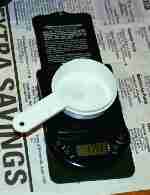 Using the scale is easy. Just put whatever you want to weigh on the scale and the weight shows on the display. My grandsons lost my powder pan, so I went up in the cabinet and liberated a common kitchen measuring cup for this demonstration. This one is a ¼ cup measure. We don't need nearly that much powder. In this photo, we can tell that the measuring cup weighs 179.0 grains. We don't care about that, because we are measuring powder. Using the scale is easy. Just put whatever you want to weigh on the scale and the weight shows on the display. My grandsons lost my powder pan, so I went up in the cabinet and liberated a common kitchen measuring cup for this demonstration. This one is a ¼ cup measure. We don't need nearly that much powder. In this photo, we can tell that the measuring cup weighs 179.0 grains. We don't care about that, because we are measuring powder.
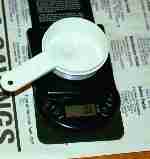 In this photo, I have touched the
Zero button, and the scale ignores the weight of the measuring cup. This
is the Tare feature I talked about earlier. The old-style balance beam scale is set up to show 0.0 weight
when the powder pan is in place. Generally, getting a balance beam scale set up to register Zero took a few
minutes. The digital scale does the same thing with the touch of a button. We want the digital scale to register 0.0 when the powder pan is in place, just like we want the old-style balance beam scale to
register Zero with the powder pan in place. Through the
magic of digital processing, the scale can be set up to
ignore the weight of whatever container is placed on it. In
this example I am using a kitchen measuring cup, but I could
just as easily be using a powder pan, or an empty cartridge
case, or whatever I want to use. Instead of going through
the motions of leveling the balance beam and adjusting the
beam to give us a zero reading, with a digital scale, we
simply place the empty container on the scale, touch the
Zero button, and Voila! The scale is ready to measure
whatever you put in the container. In this photo, you can
easily see the buttons on the scale, from left to right,
they are: Unit, Pieces, Zero, and On/Off. The scale comes
with complete instructions and has a calibration weight
included. In this photo, I have touched the
Zero button, and the scale ignores the weight of the measuring cup. This
is the Tare feature I talked about earlier. The old-style balance beam scale is set up to show 0.0 weight
when the powder pan is in place. Generally, getting a balance beam scale set up to register Zero took a few
minutes. The digital scale does the same thing with the touch of a button. We want the digital scale to register 0.0 when the powder pan is in place, just like we want the old-style balance beam scale to
register Zero with the powder pan in place. Through the
magic of digital processing, the scale can be set up to
ignore the weight of whatever container is placed on it. In
this example I am using a kitchen measuring cup, but I could
just as easily be using a powder pan, or an empty cartridge
case, or whatever I want to use. Instead of going through
the motions of leveling the balance beam and adjusting the
beam to give us a zero reading, with a digital scale, we
simply place the empty container on the scale, touch the
Zero button, and Voila! The scale is ready to measure
whatever you put in the container. In this photo, you can
easily see the buttons on the scale, from left to right,
they are: Unit, Pieces, Zero, and On/Off. The scale comes
with complete instructions and has a calibration weight
included.
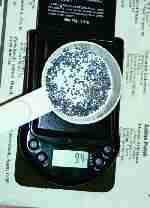 Now we have added powder to the scale. The display tells me that I have exactly 9.4 grains of powder in the scale. Just so you'll know, I don't use that particular powder charge for anything, but a careful examination of the powder will tell you what kind of powder I am weighing now. It is a flake powder, and it has blue dots in it. What do you think I am using in this photo? Now we have added powder to the scale. The display tells me that I have exactly 9.4 grains of powder in the scale. Just so you'll know, I don't use that particular powder charge for anything, but a careful examination of the powder will tell you what kind of powder I am weighing now. It is a flake powder, and it has blue dots in it. What do you think I am using in this photo?
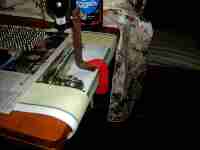 I reload on my kitchen table, and if you look at the photo to the right, you will see my powder measure set up with a lightweight C-clamp on the edge of the table. That C-clamp holds the measure securely, but I am always careful to roll newsprint around the edge of the table and clamp everything with paper, protecting my wife's kitchen table. I don't want to mar the fine finish she keeps on that piece of furniture.
The versatility of the Jennings scale is something I haven't yet completely explored, but should be easy to use. If I remember my high school science class correctly, a cubic centimeter of water weighs just exactly one gram at room temperature. Lets say you are trying to get a high powder density loading on a particular case and you need to know the capacity of that case. With the Jennings scale that would be simple. Set the scale to measure grams, put the case on the scale and touch the Zero button. Fill the case with water to the case neck and read the grams of water directly off the scale. If that case holds 2.4 grams of water, then you know that the usable capacity of the case is 2.4 cc of powder. Using a powder density table, you can easily figure the amount of powder that will fill that case to the neck. I reload on my kitchen table, and if you look at the photo to the right, you will see my powder measure set up with a lightweight C-clamp on the edge of the table. That C-clamp holds the measure securely, but I am always careful to roll newsprint around the edge of the table and clamp everything with paper, protecting my wife's kitchen table. I don't want to mar the fine finish she keeps on that piece of furniture.
The versatility of the Jennings scale is something I haven't yet completely explored, but should be easy to use. If I remember my high school science class correctly, a cubic centimeter of water weighs just exactly one gram at room temperature. Lets say you are trying to get a high powder density loading on a particular case and you need to know the capacity of that case. With the Jennings scale that would be simple. Set the scale to measure grams, put the case on the scale and touch the Zero button. Fill the case with water to the case neck and read the grams of water directly off the scale. If that case holds 2.4 grams of water, then you know that the usable capacity of the case is 2.4 cc of powder. Using a powder density table, you can easily figure the amount of powder that will fill that case to the neck.
Suppose your wife has some loose gemstones, but you are not sure about the carat weight of those stones. Just set the scale to weigh carats and weigh the stones. Simple. I like it a lot. It is lightweight, portable, and accurate. This scale is going to get a lot of use.
Copyright 2004 by Dennis Dezendorf
|




